ABSTRACT
Objectives
The key objective of this work is to establish a stability-indicating UHPLC technique for measuring amlodipine and enalapril maleate in bulk and pharmaceutical formulations
Materials and Methods
The mobile phase consisted of 0.02M KH2PO4 buffer: Methanol (70:30 v/v). The chromatographic separation was carried out using an Analytical Technologies UHPLC-3000 equipment in conjunction with a variable wavelength programmable UV identifier and a Rheodyne injector equipped with a 5 μL fixed circle. Detection was done at 224 nm with the flow rate of 0.3 mL/min.
Results
Amlodipine’s retention time was determined to be 0.7 min, while Enalapril’s was 1.2 min. The linearity range for Amlodipine and Enalapril was discovered to be 5–25 μg/mL. The technique has been examined in accordance with ICH (International Conference on Harmonisation) standards. A procedure is precise and accurate if the %RSD is less than two. Amlodipine’s limit of detection and quantitation ranges are 0.12–0.37 μg/mL and Enalapril’s range is 0.10–0.30 μg/mL, respectively. The procedure proved to be simple, linear, swift, exact, accurate, repeatable, and reliable. The drug was prone to acid, basic, and oxidation conditions, according to the stress degradation research.
Conclusion
Even in actual samples, the techniques clearly distinguished between the drugs and degradation products. The method was proved as a stability indicating method and can be used in practice for bulk and the dosage forms and also to evaluate the shelf life.
INTRODUCTION
Amlodipine (ADP) is a medication often used to treat high blood pressure and angina. Amlodipine has antioxidant properties as well as the ability to stimulate the generation of Nitric Oxide (NO), a vasodilator that reduces blood pressure.1 It is an antihypertensive medicine that belongs to the class of pharmaceuticals known as dihydropyridine calcium channel blockers. ADP is 3-ethyl 5-methyl 2-[(2-aminoethoxy) methyl]-4-(2-chlorophenyl)-6-methyl-1,4-dihydropyridine- 3,5-dicarboxylate; benzene sulfonic acid.2–4 The chemical structure are shown in Figure 1.
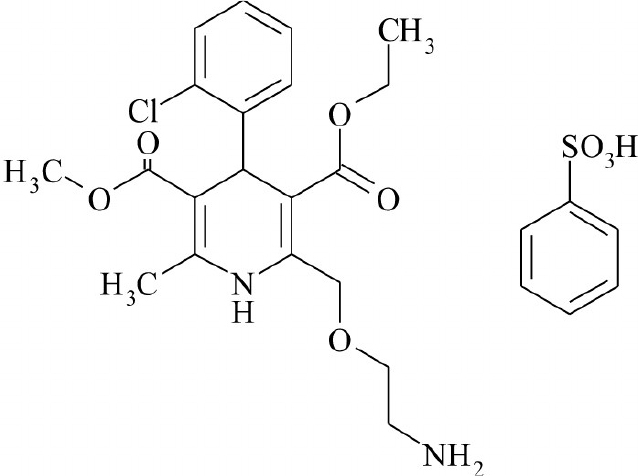
Figure 1:
Structure of Amlodipine besylate.
Enalapril (ELP) is a prodrug of the Angiotensin-Converting Enzyme (ACE) inhibitor family of drugs. It operates on the renin-angiotensin-aldosterone pathway, which regulates blood pressure as well as fluid and electrolyte balance. It is a non-sulphydryl anti-hypertensive medication that is used orally. It was developed using molecular modelling to focus targeted research. Enalapril lowers blood pressure by relaxing and expanding blood arteries, making it simpler for the heart to flow blood throughout the body. Enalapril maleate has the chemical formula (2S).-1-[(2S)-2-[(1S)-1-(Ethoxycarbonyl)-3 -phenylpropyl] amino propanoyl Z-pyrrolidine-2-carboxylic acid-butenedioate.5 The chemical structure of ELP is shown in Figure 2.
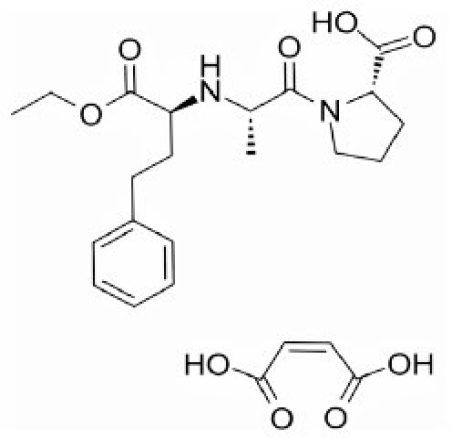
Figure 2:
Structure of Enalapril Maleate.
Hypertension is a medical condition in which the blood exerts a high pressure on the blood vessel walls. Because of this condition, the heart has to work harder to pump blood throughout the body. Stroke, heart failure, heart attack, and kidney failure are all major health concerns that can be caused by hypertension. Amlodipine and enalapril are used together to treat hypertension and successfully lower blood pressure. It works by relaxing blood arteries, allowing blood to flow more freely and allowing the heart to pump blood more efficiently. A review of the literature reveals that several UV,6–13 HPTLC,14–16 HPLC,13,16,17–27 and UPLC28 techniques have been described for the ADP and ELP alone or in combination with other medicines. To the best of our knowledge, no UHPLC method for determining stability has been published for ADP and ELP combination dose form. The study’s purpose is to establish a simple, robust, and precise technique for quantifying ADP and ELP in bulk and dosage form at the same time. The method has been verified according to ICH guidelines.29,30 The formulation sample recoveries were in good agreement with their label claims, and no formulation excipients interfered with the estimate. As a result, this approach is straightforward and practical for regular examination of bulk medicines in pure form and combinations.
MATERIALS AND METHODS
Instruments
Analytical Technologies UHPLC-3000 equipment, a variable wavelength programmable UV identifier, and a Rheodyne injector with a 5l fixed circle were used for the chromatographic operation. The opposing stage was a Cosmosil C18 (100mm x 2.1ID, particle size: 1.7 micron). For spectrophotometer judgements and gauging, the UV-3000-M spectrophotometer and the Wenser High Precision Balance Model: PGB 100 electronic equilibrium were employed separately.
Chemicals and reagents
Amlodipine and Enalapril was procured from Pharma Tech Solutions. The fixed-dose combination of tablet containing Amlodipine and Enalapil (AMTAS-E 5+5 mg) is FDA-approved for the treatment of hypertension purchased from local market; Merck Specialities Private Limited, Mumbai, provided UHPLC grade Methanol and water.
Chromatographic conditions
Cosmosil C18 (100mm x 2.1ID, particle size: 1.7 micron) was used for the chromatographic technique at 224 nm. The mobile phase for elution was 0.02M KH2PO4 buffer: methanol, and the standard and sample solutions were prepared in the same solvent. By infusing 5μL and increasing the flow rate to 0.3 mL/min, the elution was examined.
Preparation of (0.02M KH2PO4 buffer)
Dissolve 0.5 g of Sodium Chloride and 0.5 g of 1-Hexane Sulphonic Acid Sodium salt in 800 mL water, sonicated to dissolve fully, then diluted to volume 1000 mL with water. The pH was adjusted to 3.2 using dilute Orthophosphoric acid, then filtered and degassed via a 0.45 m filter.
UHPLC Method Development
Preparation of Standard Stock solutions
Accurately Weighed and placed 25 mg ADP and 25 mg ELP working standards into a 100 mL clean dry volumetric flask, sonicated for 5 min, and made up to final volume using diluents. The ultimate concentration of amlodipine is 250 μg/mL, while the final concentration of enalapril is 250 μg/mL. The working standard solutions for these drugs were created by diluting the corresponding stock solution with mobile phase.
Validation of RP-UHPLC method29,30
The optimised RP-UHPLC technique was verified in accordance with ICH Q2 (R) standards.
Linearity
Different concentrations of test solutions were injected individually, and chromatograms were obtained. A series test preparation of Amlodipine and Enalapril were made by placing 1 mL – 5 mL of the stock solution containing ADP (250 μg/mL) and ELP (250 μg/mL) in five 10 mL volumetric flasks and filling to the mark with mobile phase. Under the optimised chromatographic conditions, a 5 μL volume of each concentration was injected into UHPLC three times.
Accuracy
The accuracy is expressed as a percentage of recovery. A known amount of ADP and ELP standard drugs powder equivalent to 50% to 150% of the label claim was added, mixed, and analysed through chromatograms in optimised mobile phase.
Precision
The intraday precision study consisted of developing a test solution of the same concentration and assessing it three times during the day. On two distinct days, the same procedure was applied to assess interday precision. The result was given as %RSD.
Limit of Quantitation (LOQ) and Limit of Detection (LOD)
The LOD and LOQ were estimated using the slope(s) of the calibration curve and the Standard Deviation (SD) of the peak areas. It was determined by using the formulae LOD = 3.3 s/s and LOQ = 10 s/s.
Robustness
Robustness was assessed by changing the chromatographic conditions such as mobile phase composition, detection wavelength, flow rate, and so on, and the percentage RSD should be reported. Small modifications in the ideal circumstances were allowed, and the method’s robustness was determined. Individual variations in detecting wavelength of 2 nm and flow rate of 0.1 mL/min were tested. In the ideal circumstances, solutions of 100% test concentration with the required changes were injected into the system in triplicate.
Ruggedness
Ruggedness is the investigation of the effect of external parameters on the approach. To assess the robustness of the suggested approach, factors were purposefully altered. These parameters included system variation, various analysts, and atmospheric fluctuations. Two distinct analysts prepared the test solution according to the test procedure and injected three concentrations of test solution into the UHPLC system at a flow rate of 0.3 mL/ min.
Assay of marketed formulation
20 tablets of the commercial formulation (AMTAS-E 5+5 mg) were ingested, weighed individually, and powdered. The average weight of the tablet determined and powder equivalent to one tablet was weighed and transferred to a 100 mL volumetric flask, where mobile phase was added to make up the volume. Sonicate for 10 min, occasionally spinning. The aforementioned solution was filtered via a 0.45 m membrane filter, yielding a stock solution containing 200 μg/mL of amlodipine and 200 μg/mL of enalapril. 0.75 mL of solution was withdrawn for analysis, diluted to 10 mL, and fed into the system.
System suitability
To validate the system, method and column performance, system suitability characteristics were examined. The system was tested for system applicability by injecting a standard solution of Amlodipine and Enalapril five times.
Force degradation study31,32
The ADP and ELP drugs combinations were subjected to forced degradation experiments. The principal stress conditions were 1N HCl (1 hr at 60°C), 1N NaOH (1 hr at 60°C), 3% H2O2 (24 hr), dry heat (24 hr), and UV radiation (24 hr).
RESULTS
Optimization of RP-UHPLC method
The UHPLC technique was established for evaluating Amlodipine and Enalapril. Various mobile phases were investigated for technique optimisation, but suitable retention time, hypothetical plates, and good resolution were obtained with 0.02 M KH2PO4 buffer: methanol utilising Cosmosil C18 (100 mm x 2.1 mm ID, particle size: 1.7 m) using gradient method. (Table 1).
| Mobile phase | 0.02M KH2PO4 buffer: methanol |
|---|---|
| Selection of column | Cosmosil C18 (100 mm x 2.1 mm ID, Particle size: 1.7 μm) |
| Injection volume | 5 μL |
| Flow rate | 0.3 mL/min |
| Column temperature | Room Temperature |
| Detection wavelength | 224 nm |
| Run Time | 2.5 min |
| Retention time | Amlodipine (0.7 min) and Enalapril (1.2 min) |
Linearity
The linearity of an analytical method was defined as the technique’s ability to deliver test results that are directly proportional to analyte concentration within a particular range. The graph of calibration was constructed by graphing the UHPLC chromatograph peak area against the relevant concentrations. Figure 3 shows that ADP is linear in the 5-25 μg/mL concentration range, whereas ELP is linear in the 5-25 μg/mL concentration range (Figure 4).
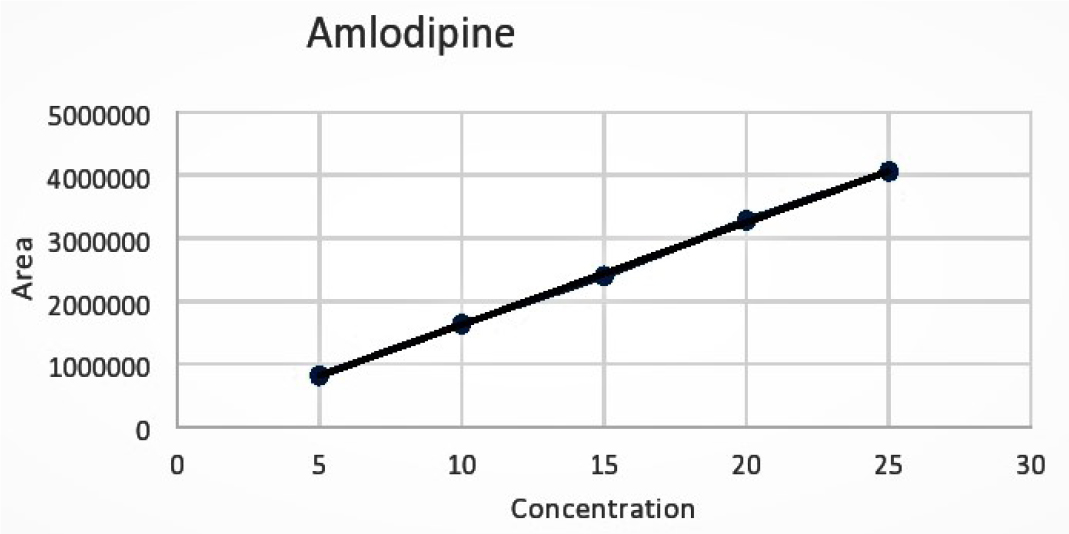
Figure 3:
Calibration curve for Amlodipine.
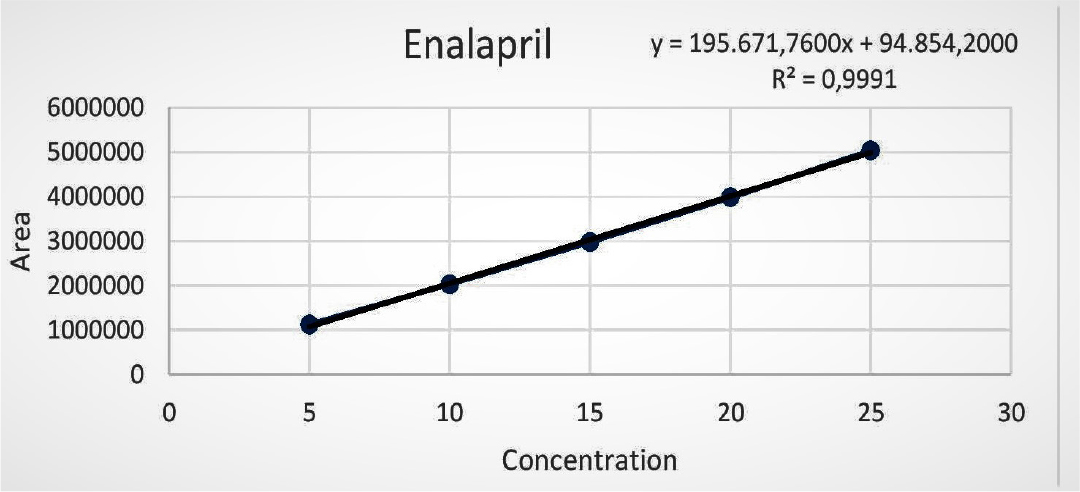
Figure 4:
Calibration curve for Enalapril.
Accuracy
The method’s accuracy defines how close the method’s results are to the true value. The results of the accuracy testing revealed that the technique is accurate within acceptable ranges. When the % RSD for ADP and ELP is calculated, all of the results are within acceptable bounds. A maximum RSD of 2.0% indicated acceptable accuracy within the range. The results are shown in Table 2.
| Level of addition | % Mean recovery* | SD | % RSD | |||
|---|---|---|---|---|---|---|
| ADP | ELP | ADP | ELP | ADP | ELP | |
| 50% | 99.65 | 99.71 | 0.16 | 1.03 | 0.16 | 1.03 |
| 100% | 99.70 | 99.99 | 0.22 | 0.81 | 0.22 | 0.81 |
| 150% | 99.88 | 100.12 | 0.23 | 0.37 | 0.23 | 0.37 |
Precision
The repeatability of test results is ensured by intraday and interday precision. Amlodipine and Enalapril both had % RSD values less than 2. Results are shown in Table 3.
| Drug | Conc. [g/mL] | Intra- day Amount found [g/mL] | Inter- day Amount found [g/mL] | ||
|---|---|---|---|---|---|
| SD [n = 3] | % RSD | SD [n = 3] | % RSD | ||
| ADP | 5 | 10393.36 | 1.28 | 6542.69 | 0.80 |
| 15 | 12178.68 | 0.51 | 6062.04 | 0.25 | |
| 25 | 11290.12 | 0.28 | 14250.39 | 0.35 | |
| ELP | 5 | 11307.53 | 1.00 | 5841.79 | 0.53 |
| 15 | 34989.18 | 1.17 | 12471.05 | 0.42 | |
| 25 | 23612.47 | 0.47 | 6804.75 | 0.14 | |
Robustness
Robustness was investigated using various deliberate alterations in chromatographic settings, such as changes in flow rate and wavelength. RSD was shown to be less than 2% in the Amlodipine and Enalapril robustness studies. As a result, it is strong and adheres to ICH criteria. Results are shown in Table 4.
| Sl. No. | Parameter | Amlodipine | Enalapril | ||||||
|---|---|---|---|---|---|---|---|---|---|
| Area | Mean | SD | % RSD | Area | Mean | SD | %RSD | ||
| 1 | Change in Flow rate (mL/min) | 2394142 | 2390202 | 13782 | 0.58 | 2978784 | 2988690 | 9642 | 0.32 |
| 2 | 2401587 | 2998046 | |||||||
| 3 | 2374879 | 2989241 | |||||||
| 1 | Change in Wavelength (nm) | 2401023 | 2392473 | 12280 | 0.51 | 3001205 | 2992453 | 12496 | 0.42 |
| 2 | 2397995 | 2998013 | |||||||
| 3 | 2378401 | 2978142 | |||||||
Ruggedness
Ruggedness was studied by different analyst. From ruggedness study % RSD was found to be within limit of 2% for the ADP and ELP. Hence it is complying as per ICH guidelines.
Specificity
The specificity of the approach was determined by analysing reference drugs and sample. Excipients and contaminants had no effect on the standard drugs. As a result, the procedure is distinct (Figure 5).
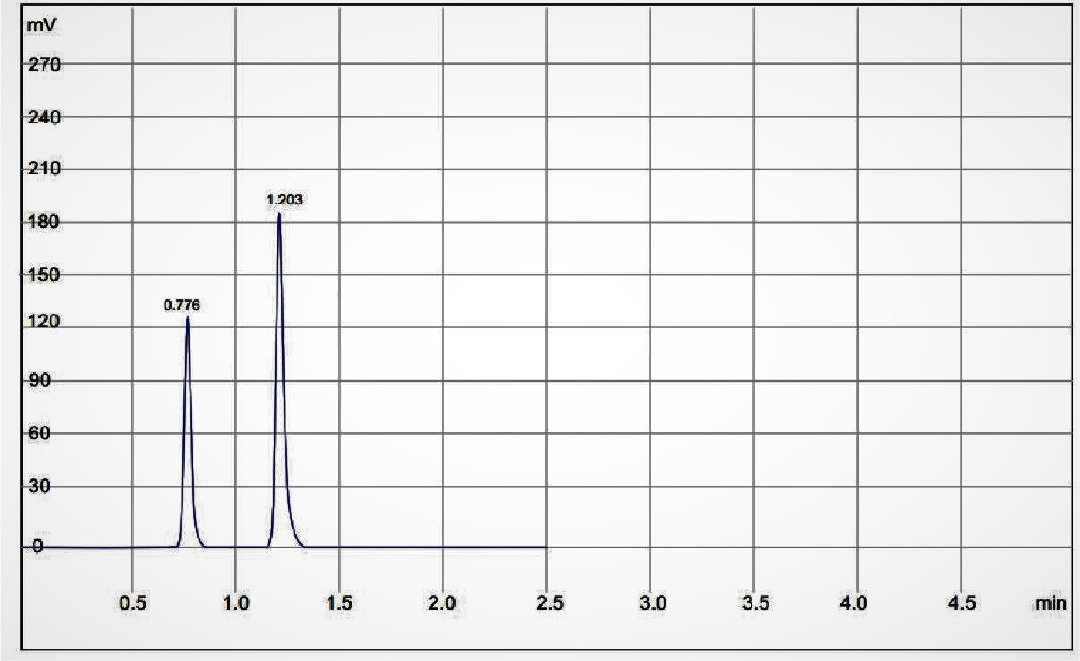
Figure 5:
Chromatograph of Amlodipine and Enalapril.
% Assay of Marketed formulation
The % Assay of Intas Pharmaceutical’s AMTAS – E (5 mg+5 g) commercial formulation was computed. The percentage assay was discovered to be ADP (98.40%) and ELP (99.31%), which was in good accord with the label claim.
System Suitability Parameters
The system, method, and column performance were validated by testing system suitability features. Five times, a standard solution of ADP and ELP was injected into the system, and the system’s suitable features were evaluated. Results are shown in Table 5.
| Parameter | ADP | ELP |
|---|---|---|
| Retention Time (min) | 0.744 | 1.253 |
| Theoretical plates | 9878 | 10552 |
| Asymmetry Factor | 1.08 | 1.11 |
| Tailing factor | 1.12 | 1.05 |
Degradation studies31,32
Stress assessment of the drug material can aid in identifying the anticipated degradation products as well as the analytical technique’s stability and specificity. Degradation of the materials with acid, alkali, oxidation, thermal heat and photo light showed some new peaks with different Rt values., as shown in Figures 6, 7, 8, 9 and 10.
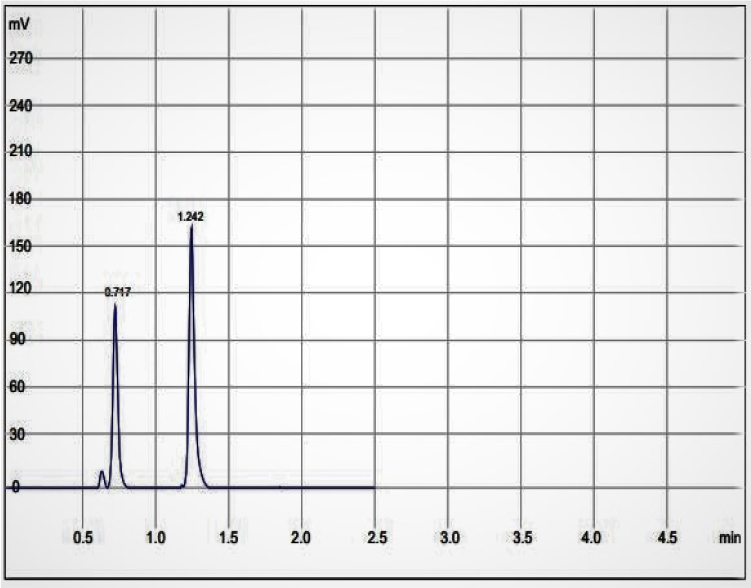
Figure 6:
Acid Stressed Chromatogram.
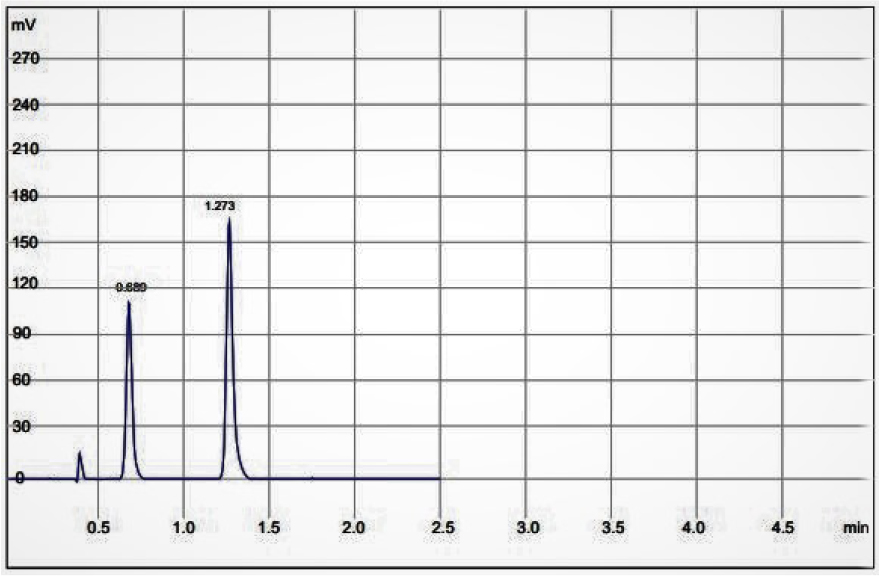
Figure 7:
Alkali Stressed Chromatogram.
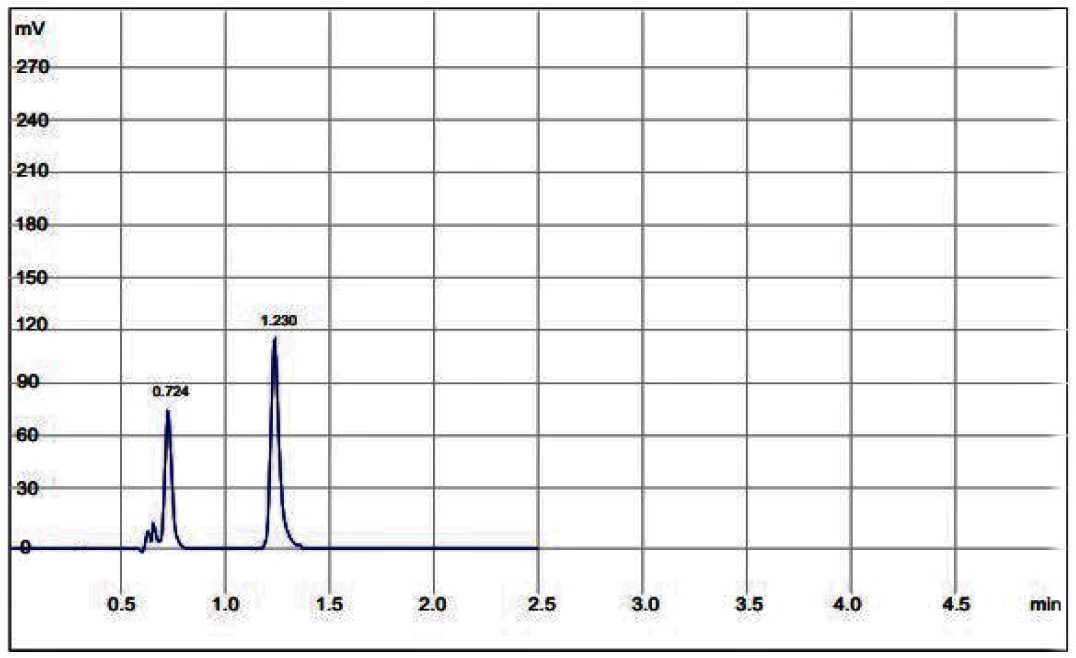
Figure 8:
Peroxide Stressed Chromatogram.
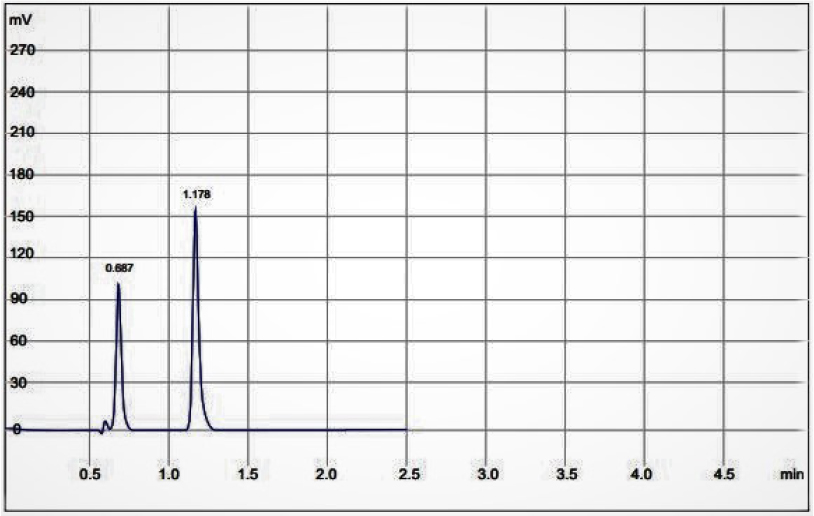
Figure 9:
Thermal Stressed Chromatogram.
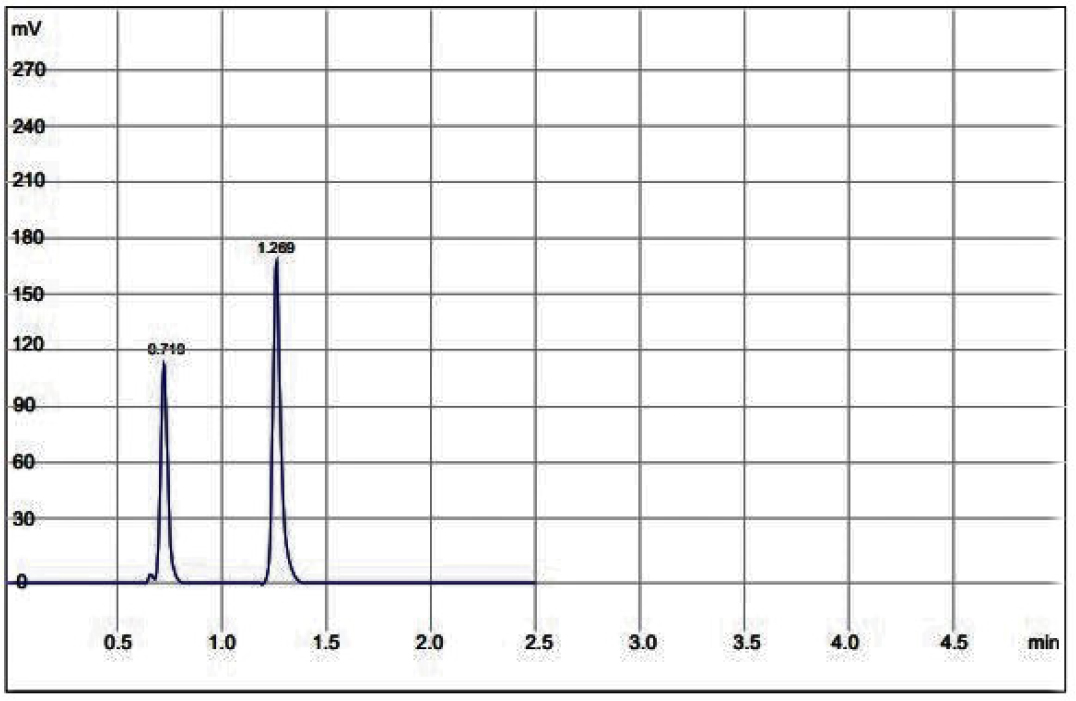
Figure 10:
Photolytic Stressed Chromatogram.
Degradation tests were carried out on solutions containing Amlodipine (15 g/mL) and Enalapril (15 g/mL). Results are shown in Table 6.
| Sl. No. | Condition | Drugs | Area of sample | Area of Standard | % Drug recovered | % Degradation |
|---|---|---|---|---|---|---|
| 1 | Acid stress | ADP | 2301254 | 2394765 | 96.10 | 3.90 |
| ELP | 2923464 | 2977653 | 98.18 | 1.82 | ||
| 2 | Alkali Stress | ADP | 2271415 | 2394765 | 94.85 | 5.15 |
| ELP | 2836540 | 2977653 | 95.26 | 4.74 | ||
| 3 | Oxidative Stress | ADP | 2102448 | 2394765 | 87.79 | 12.21 |
| ELP | 2631448 | 2977653 | 88.37 | 11.63 | ||
| 4 | Thermal Stress | ADP | 2168035 | 2394765 | 90.53 | 9.47 |
| ELP | 2910236 | 2977653 | 97.74 | 2.26 | ||
| 5 | Photolytic Stress | ADP | 2365410 | 2394765 | 98.77 | 1.23 |
| ELP | 2948993 | 2977653 | 99.04 | 0.96 |
DISCUSSION
The UHPLC method for simultaneous quantification of amlodipine and enalapril was developed and validated. The mobile phase was a 70:30 v/v mixture of 0.02M KH2PO4 buffer and methanol. The linearity ranges of Amlodipine and Enalapril were found to be 5-25 μg/mL and 5-25 μg/mL, respectively. The calibration curve was plotted, and the ADP regression equation was found to be y = 1,62,671.3400x – 3,976.3000 with a correlation coefficient (r2) of 0.9996, while the ELP regression equation was found to be y = 1,95,671.7600x + 94,854.2000 with a correlation coefficient (r2) of 0.9991. The method’s appropriateness for quantitative measurement of the compounds is demonstrated through validation in line with ICH principles. The proposed methods’ reliability and analytical performance, including linearity, range, precision, accuracy, detection, and quantitation limitations, were statistically validated.
According to the Accuracy research, the percent recovery of Amlodipine is 99.46-100.11% and Enalapril is 98.68-100.73%, both of which are within the ICH standards. Intraday and interday precision ensure that % RSD remained within ICH criteria, i.e., NMT 2 for both Amlodipine and Enalapril. Amlodipine has a detection limit of 0.12 g/mL – 0.37 g/mL and Enalapril has a detection limit of 0.10 g/mL – 0.30 g/mL. Robustness was examined using deliberate variation, i.e., a change in flow rate and a change in wavelength that was within 2% of RSD according to ICH norms. The ruggedness testing yields results within 2% of the variance in Analyst examined. Amlodipine (98.40%) and Enalapril (99.31%) were reported to have the highest % assay of AMTAS-E (5 mg+5 mg). When ADP and ELP were treated to various stress conditions, the proposed methods were able to efficiently separate the medication from its degradation products and were thus regarded as good stability-indicating procedures. The degradation pathway33,34 of DTV, LMV and TDF are shown in Figures 11 and 12.
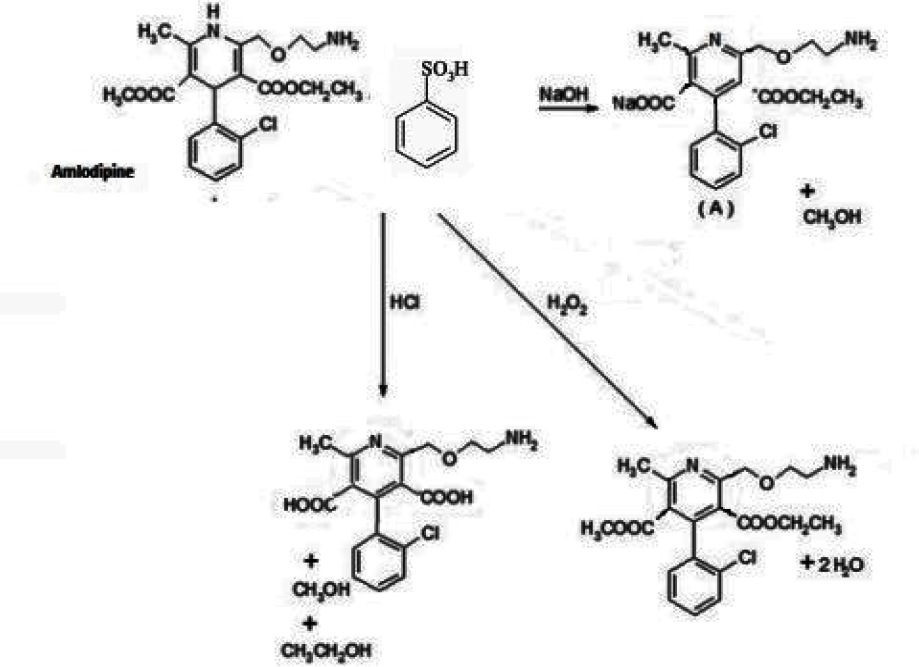
Figure 11:
Degradation Pathway of ADP.
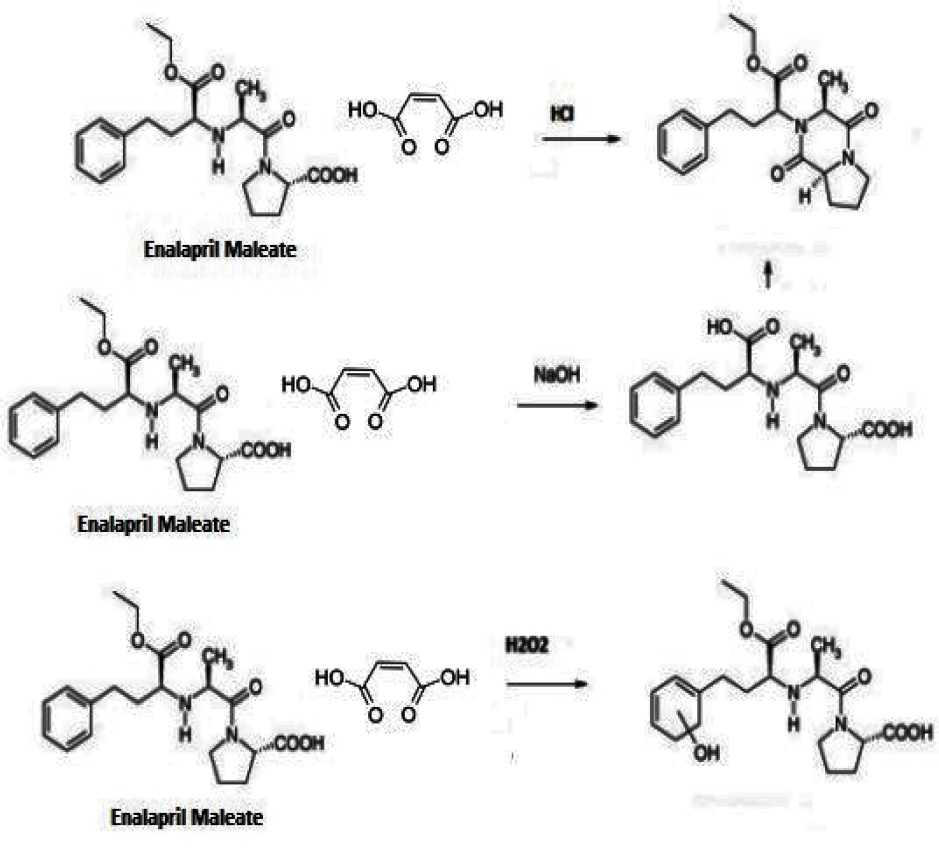
Figure 12:
Degradation Pathway of ELP.
Figure 11 shows the degradation pathway of ADP in acid, base and oxidation condition. The ADP was found to be prone to HCl, NaOH and H2O2and shows degradation. In acidic condition leads to formation of acid as a degradation product. In basic condition it leads to form a sodium salt. In oxidation condition it forms esters.
Figure 12 shows the degradation pathway of ELP. The drug showed instability in acid and alkali and oxidation while it remained stable in dry heat and photolightic conditions. When ELP treated with alkali and peroxide the hydroxyl radical was generated.
Studies on forced degradation provide data on potential degradation pathways, active component degradation products, and can help to clarify the composition of the degradants. However, they aid in the creation of a stability indicating strategy. The degradation products generated by forced degradation studies are potential degradation products that may or may not emerge under pertinent storage circumstances. With IR, the degradation products were verified. The degraded sample spectra of ADP and ELP are shown in Figures 13 and 14.
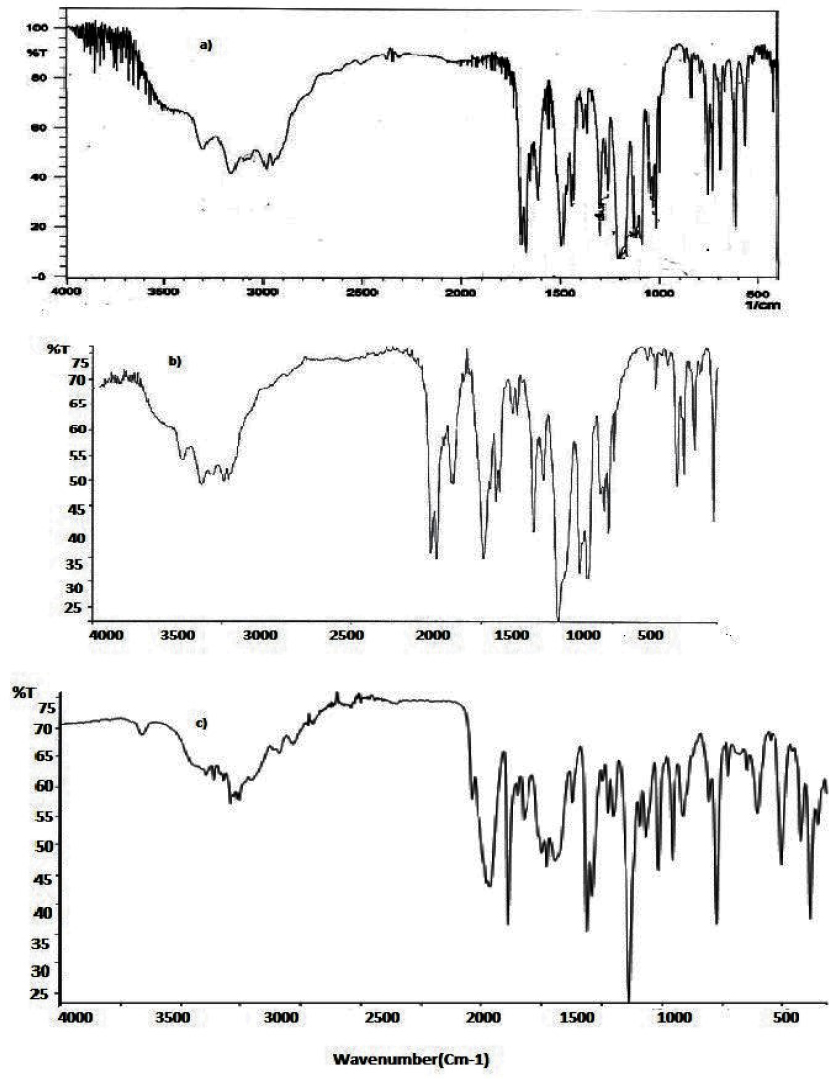
Figure 13:
IR Spectra of ADP (a) its acidic degradate (b) Its alkaline degradate and (c) Its oxidation degradate.
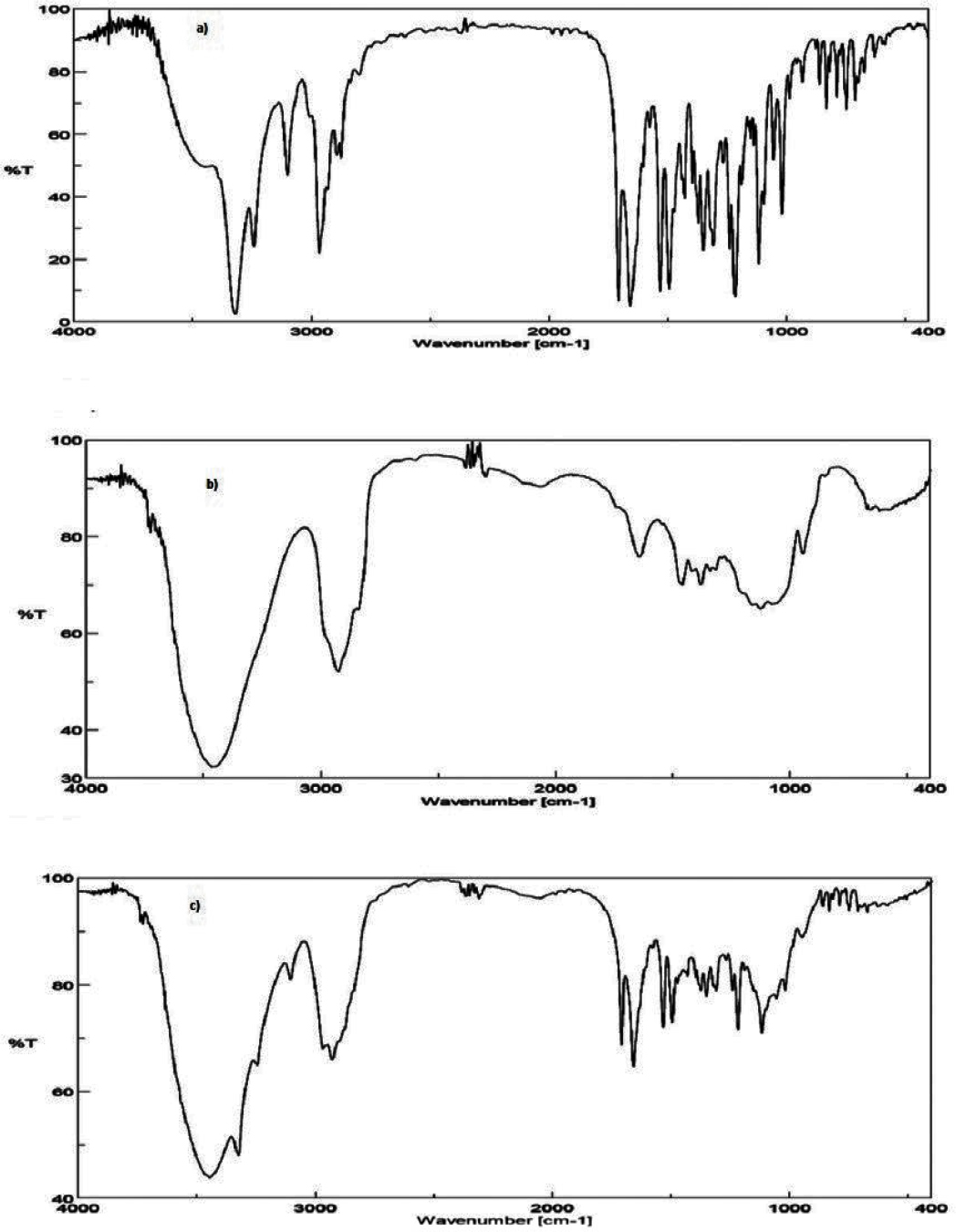
Figure 14:
IR Spectra of ELP (a) its acidic degradate (b) Its alkaline degradate and (c) Its oxidation degradate.
Figure 13 depicts the ADP’s deterioration. The ADP acidic degradate’s IR spectra revealed a wide band of the (OH) group at 3400 cm-1. It appears as a broad band of the (OH) group at 3400 cm-1 in the IR spectrum of an alkaline degradate, and it also appears as a broad band of the (OH) group at 3400 cm-1 in an oxidative degradate.
Figure 14 depicts the decline of ELP. The band of the ester moiety’s C=O group appeared in the IR spectrum of the acidic degradate at 1740 cm1 and the wide band of the (OH) group appeared at 3400 cm1. In the IR spectrum of an alkaline degradate, a broad band of the (OH) group can be seen at 3400 cm1 and a CH aromatic band can be seen at 3179 cm1, but in the spectrum of an oxidative degradate, a broad band of the (OH) group can be seen at 3400 cm1.
CONCLUSION
The recommended chromatographic technique for identifying Amlodipine and Enalapril from pure and dosage forms was found to be straightforward, precise, accurate, fast, and specific. The mobile phase used in method development is easy and inexpensive to prepare. In the formulation, sample recoveries were excellent. Among all the established methods, this approach is the most cost-effective and has the shortest run time, allowing for rapid analysis. As a result, this method may be simply and conveniently used for in vitro dissolution and routine analysis of Amlodipine and Enalapril in Pharmaceutical dosage form. The degradation products generated during the stability investigation were well isolated from the pure drugs, revealing the uniqueness of the developed technique.
Cite this article:
Gaikwad N, Bhangale C, Bhandare S. Simultaneous Estimation of Amlodipine and Enalapril Maleate by Stability Indicating UHPLC Method.
ACKNOWLEDGEMENT
The authors extend they’re thanks to PRES’s College of Pharmacy for Women in Nashik for providing the essential facilities for this research.
The authors extend they’re thanks to PRES’s College of Pharmacy for Women in Nashik for providing the essential facilities for this research.
ABBREVIATIONS
| mg | Milligram |
|---|---|
| ml | Mililitre |
| μg | Microgram |
| AUC | Area Under Curve |
| ICH | International Conference on Harmonization |
| R2 | Coefficient of Molar |
| Rt | Retention time |
| N | Theoretical Plates |
| SD | Standard Deviation |
| % RSD | % Relative Standard Deviation |
| LOD | Limit of Detection |
| LOQ | Limit of Quantitation |
| RP-UHPLC | Reverse Phase-Ultra High Performance Liquid chromatography |
References
- Available from: https://go.drugbank.com/salts/DBSALT001054.
- Available from: https://go.drugbank.com/drugs/DB00381
- Fares H, DiNicolantonio JJ, O’Keefe JH, Lavie CJ. Amlodipine in hypertension: a first-line agent with efficacy for improving blood pressure and patient outcomes. Open Heart. 2016;3(2) [PubMed] | [CrossRef] | [Google Scholar]
- Meredith PA, Elliott HL. Clinical pharmacokinetics of amlodipine. Clin Pharmacokinet. 1992;22(1):22-31. [PubMed] | [CrossRef] | [Google Scholar]
- Available from: https://go.drugbank.com/drugs/DB00584.
- Chaudhari BG. Development and validation of dual wavelength spectrophotometric method for simultaneous estimation of amlodipine besylate and enalapril maleate in combined dosage form. Ijpcbs. 2012;2(4):626-32. [PubMed] | [CrossRef] | [Google Scholar]
- Garg GG, Saraf SS. Development and validation of simultaneous estimation of enalapril maleate and amlodipine besylate in combined dosage forms. Trends Appl Sci Res. 2008;3(3):278-84. [CrossRef] | [Google Scholar]
- Naveed S, Qamar H. Simple UV spectrophotometric assay of amlodipine. American journal of chemistry and application. J Chem Appl. 2014;1(4):66-9. [CrossRef] | [Google Scholar]
- Roshanara MA, Bhavani MI, Prabahar AE, Rao RN. Development and validation of UV spectrophotometric method for analysis of enalapril maleate in bulk and pharmaceutical dosage form. Indo Am J Pharm Sci. 2019;6(2):4049-53. [CrossRef] | [Google Scholar]
- Gidwani B, Patel L, Gupta A, Kaur CD. Ultra-violet spectrophotometric method for estimation and validation of amlodipine in bulk and tablet formulation. J Anal Pharm Res. 2017;4(6) [CrossRef] | [Google Scholar]
- Dhake AS, Kasture VS, Sayed MR. Spectrophotometric method for simultaneous estimation of amlodipine besylate and enalapril maleate in tablets. Indian Drugs. 2002;39(1):14-7. [CrossRef] | [Google Scholar]
- Prasad CVN, Saha RN. Simultaneous determination of amlodipine-enalapril maleate and amlodipine-lisinopril in combined tablet preparations by derivative spectrophotometry. J Pharm Pharmacol. 2010;5(6):383-8. [CrossRef] | [Google Scholar]
- Masih M. Method development and validation for simultaneous estimation of amlodipine besylate and enalapril maleate in solid dosage form. Int J Pharm Chem Anal. 2021;8(3):129-33. [CrossRef] | [Google Scholar]
- Dangi M, Chaudhari D, Sinker M, Racha V, Damle MC. Stability indicating HPTLC method for estimation of nebivolol hydrochloride and amlodipine besylate in combination. Eur Asian J Anal Chem. 2010;5:161-9. [CrossRef] | [Google Scholar]
- Mennickent SC, Rivas C, Vega MA, De Diego MG. A stability indicating HPTLC method for quantification of enalapril maleate in tablets. J Chil Chem Soc. 2013;58(2):1737-40. [CrossRef] | [Google Scholar]
- Jain PS, Patel MK, Bari SB, Surana SJ. Development and validation of HPTLC method for simultaneous determination of amlodipine besylate and metoprolol succinate in bulk and tablets. Indian J Pharm Sci. 2012;74(2):152-6. [PubMed] | [CrossRef] | [Google Scholar]
- Logoyda L. Efficient validated method of HPLC to determine amlodipine in combinated dosage form containing amlodipine, enalapril and bisoprolol and dissolution studies with correlation. Pharmacia. 2020;67(2):55-61. https:. [CrossRef] | [Google Scholar]
- Chaudhari BG. Development and validation of RP-HPLC method for simultaneous estimation of enalapril maleate and amlodipine besylate in combined dosage form. J App Pharm Sci. 2012;2(9):54-7. [CrossRef] | [Google Scholar]
- Koppala S, Ranga Reddy V, Anireddy JS. User-Friendly HPLC method development and validation for determination of enalapril maleate and its impurities in enalapril tablets. J Chromatogr Sci. 2017;55(10):979-88. [PubMed] | [CrossRef] | [Google Scholar]
- Masih M, Mittal A. Development and validation of HPLC method for simultaneous estimation of amlodipine besylate and enalapril maleate in solid dosage form. World J PharmSci. 2014;2(10):1401-5. [PubMed] | [CrossRef] | [Google Scholar]
- Naveed S, Sultana N, Arayne MS. HPLC-UV method for the determination of enalapril in bulk, pharmaceutical formulations and serum. J Anal Bioanal Techniques. 2012;03(1):130 [CrossRef] | [Google Scholar]
- Logoyda L, Ahmed M, Megied A, Kondratova Y, Trofimenko O, Korobko D, Dakhym I, et al. Development and validation of HPLC method for the simultaneous determination of enalapril maleate in present of their impurities: Application to tablet analysis. Int J App Pharm. 2018;10(1):98-102. [CrossRef] | [Google Scholar]
- Çelebier M, Kaynak MS, Altınöz S, Sahin S. HPLC method development for the simultaneous analysis of amlodipine and valsartan in combined dosage forms and dissolution studies. Braz J Pharm Sci. 2010;46(4):761-8. [CrossRef] | [Google Scholar]
- Halder D, Dan S. LC–MS/MS assay for quantitation of enalapril and enalaprilat in plasma for bioequivalence study in Indian subjects, Future Sci. 2017;3(1) [CrossRef] | [Google Scholar]
- Yasodha A, Goud GA, Surekha G, Bhargavi L. Method development and validation for the determination of amlodipine and enalapril maleate in active pharmaceutical ingredient and combined tablet dosage form by RP-HPLC. Eur J Pharm Med Res. 2023;10(4):360-7. [CrossRef] | [Google Scholar]
- Sarısaltık Yaşın D, Arslantürk Bingül A, Karaküçük A, Teksin ZŞ. Development and validation of an HPLC method using an experimental design for analysis of amlodipine besylate and enalapril maleate in a fixed-dose combination. Turk J Pharm Sci. 2021;18(3):306-18. [PubMed] | [CrossRef] | [Google Scholar]
- Chan ML, Chun MW. Determination of amlodipine in human plasma by LC-MS/ MS and Its bioequivalence study in healthy Chinese subjects. Pharmacol Pharm. 2013;4(2):191-200. [CrossRef] | [Google Scholar]
- Vuyyala G, Reddy DRS. UPLC method development and validation for simultaneous determination of amlodipine besylate and enalapril maleate in drug products. Int J Health Sci. 2022;6(S4) [CrossRef] | [Google Scholar]
- Validation of analytical procedures: text and methodology. 2005:1 Available from: http://www.ich.org/LOB/media/MEDIA417.pdf
ICH Guideline Q2. - ICH. Q2B validation of analytical procedures: methodology, consensus guidelines ICH harmonized tripartite guidelines. 1996 [CrossRef] | [Google Scholar]
- Bakshi M, Singh S. Development of validated stability indicating assay methods critical review. J Pharm Biomed Anal. 2002;28(6):1011-40. [PubMed] | [CrossRef] | [Google Scholar]
- Kats R. Forced degradation studies: regulatory considerations and implementation. Bio Pharm Int. 2005;18:1-7. [PubMed] | [CrossRef] | [Google Scholar]
- Chandramore K, Sonawane S. Overview on Development and Validation of Force degradation studies with Stability Indicating Methods. Biosci Biotechnol Res Asia. 2022;19(4):881-94. [CrossRef] | [Google Scholar]
- Blessy M, Patel RD, Prajapati PN, Agrawal YK. Development of forced degradation and stability indicating studies of drugs—a review. J Pharm Anal. 2014;4(3):159-65. [PubMed] | [CrossRef] | [Google Scholar]
